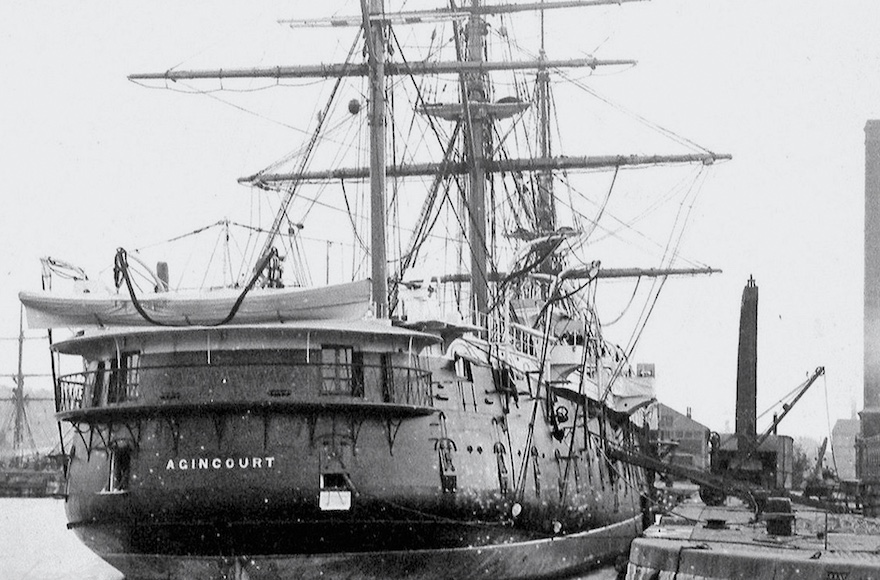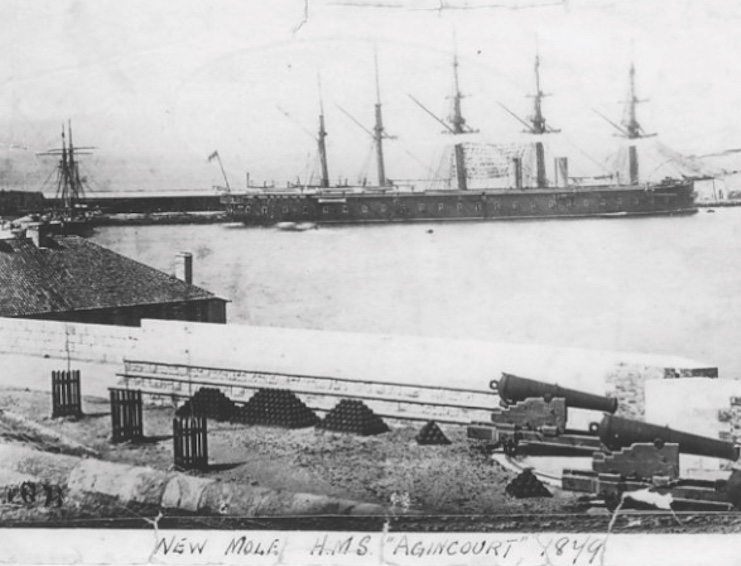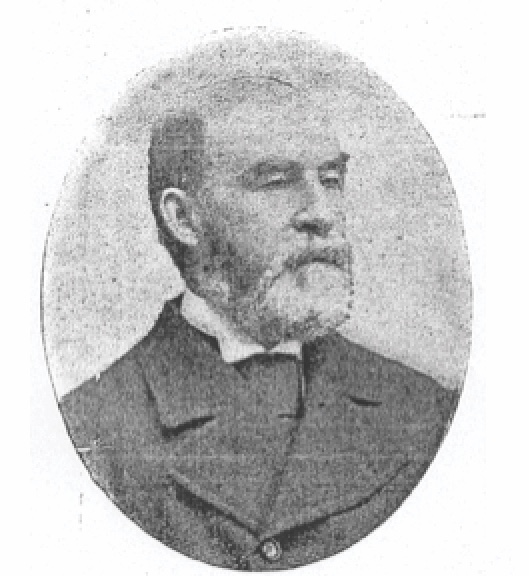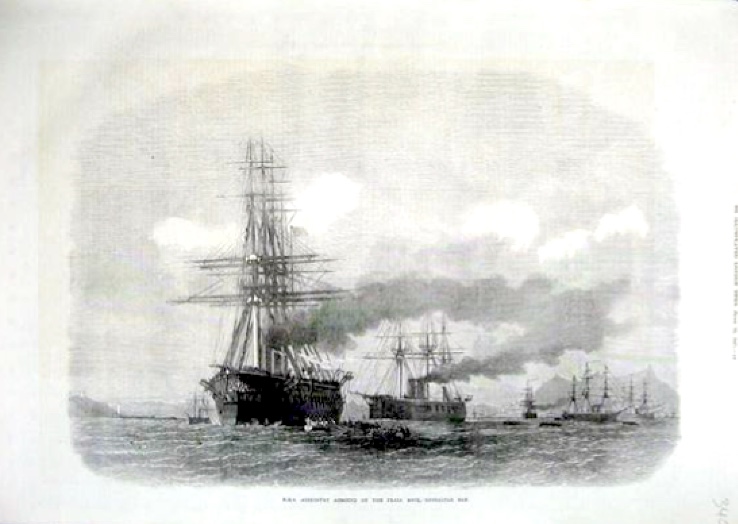THE GROUNDING OF HMS AGINCOURT
For time immemorial, the Pearl Rocks have been the curse of ships entering the Bay of Gibraltar. This was especially so in the days of sail, when ships were at the mercy of the wind and current. The list of victims of this natural navigation hazard is long and no doubt will remain silent, like a maritime spider, waiting quietly for its next victim to fall into its web of razor sharp rocks.
The rocks are situated some 1500 meters south of Punta Carnero and extend about 1000 meters west from the shore.
Most groundings have been the result of the weather, mechanical faults or enemy action, however, in the case of HMS Agincourt, the weather was fine, visibility good and no cause for concern.
Shortly after 0900hrs on the morning of 1st July 1871, seven war ships of the Channel Fleet left Gibraltar under Vice Admiral Wellesley CB on HMS Minotaur under the command of Captain Beamish. The ships formed two columns, HMS Minotaur (Capt. Wells) leaving first to head the port column, under the Admiral, followed by HMS Agincourt to lead the starboard column. These were followed my, HMS Hercules (Capt. Lord Gilford), Warrior (Capt. C.Glyn) Northumberland (Capt. Alexander) and Pigeon alternately forming the starboard and port columns.
The frigate, HMS Agincourt flew the flag of Admiral Wilton and lead the starboard column. This ship was launched in March 1865 as a Minotaur Class “Iron-clad,” which means that the wooden hull was reinforced with armour plating. At 407ft in length and displacing 10,027tons, she was a large ship for the primitive horizontal steam engines driving a single screw. In order to handle the sails and man the 4 x 9” and 24 x 7” muzzle loading guns, she had a crew of 800 men.
The squadron steamed majestically out of the bay and turned onto a heading of 225°or West South West towards Tangier, as requested by Staff Commander Kiddle, the fleet navigating officer, in the Minotaur.
As the ships formed up, and taking sightings from the San Roque and Cabrita clearing points.
They steamed at 6 knots in order to save coal. The navigating officer seemed unaware that there was a westerly current running at 4 knots. The Agincourt, under compass setting, gradually drifted out of line and was described later as having drifted seven cable lengths (1400ft) off away from the flagship instead of four (800ft).
Under normal circumstances, the Flag should have led the starboard column, which was the line closest the shore, as was the custom.
Astern of Agincourt was HMS Warrior. Commander May on board this ship registered his concern to the Captain and Officer of the Watch on seeing the Agincourt drifting towards the coast, a statement later disclaimed by Lt. Hoghton, the officer in question, who claimed that he only remarked that they were to close to the shore.
Many other officers and crew claim that the Agincourt was off station.
The charts at the time, showed the Pearl Rocks, however it was claimed that they did not show the full extent of the reef, in fact following the incident, the Admiralty carried out a survey of the area.
The first report of the plight of the Agincourt arrived in Gibraltar at 1300hrs. Reports claimed that the frigate was on the Pearl Rocks and HMS Hercules was standing by. HMS Helicon, Lee and Redpole were immediately ordered to get up steam while the tugs Lion Belge and Dockyard tug Hercules were already alongside. The three warships left shortly after towing two lighters and two punts and HMS Lee was due to pick up some more before heading out to the scene. The rest of the fleet continued to cruise the Strait.
The Agincourt was on the southeast edge rocks, up to her second mast on the starboard side and the engine room to port. In order to lighten the ship, all her guns, shot, anchors and anything heavy was being transferred to the punts and lighters. The coal was thrown overboard, no doubt to the delight of the local inhabitants as some would probably wash ashore. The lighters were being unloaded in the dockyard and Rosia Bay in the early hours of the morning when the wind veered to the East causing concern for the safety of the Agincourt, so the anchors were returned and secured to the stern in order to stop the ship swinging and becoming even further wedged on the rocks.
An anchor was put out from the Agincourt’s port bow by the Lion Belge to 100fathoms (600ft) in a south westerly direction. The stern of HMS Hercules was the attached to the stern of the stranded vessel by a 5 fathom (30ft) chain from each of the anchor hawse pipes to the stern of Agincourt. As the tide reached maximum, and the Agincourt made as light as possible, the Hercules took the strain and began to pull. A shudder passed through the ship as the vicious rocks gave up their prey. The tugs then came into play and helped the Hercules as she slid into the sea. The Spanish paddle sloop Linier also helped in the tug of war, breaking a hawser but was soon able to replace it and continue with its assistance. Unfortunately, the Agincourt slid off the rocks and collided with the stern of the Hercules, but the damage was minor.
The tugs took charge of the frigate and towed it to anchor off Sandy Bay where HMS Minotaur was riding at anchor. Next morning, HMS Minotaur, Hercules and Agincourt came round from Eastside and into the dockyard, the latter coming alongside in order have the hull examined, re-embarking her guns and ammunition and re-coaling.
As HMS Hercules came into harbour she was greeted the sounds of a band with the cheers of the ships in harbour.
An anchor, left behind, was picked up by a barge belonging to Messers Garese.
A few days later, the Agincourt accompanied the Minotaur, Valorous and Helicon set sail for England.
At the Court Martial that followed their arrival in England, Staff Commander Kiddle, the Fleet Navigating Officer confirmed that the Agincourt had drifted off station, but confirmed that the use of San Roque and Cabrita marks were unreliable for navigation. Admiral Wellesley, in his evidence, stated that both columns had been swept towards Pearl Rock whereas the navigating officer was under the impression that the current was to the east and that the incident was an accident. Staff Commander MacFarlane of the Northumberland, stated that the course that was set was very close and that the slightest set of the current would take her on the shoal. He also considered that the Admiralty Sailing Directions were a contributing factor. Captain Glyn of the Warrior, considered that the course of WSW and the slow speed was very dangerous for a large ship like the Agincourt. At slow speeds, the ship’s rudder does not react effectively and can easily be pushed off course by the current.
Under normal circumstances the Admiral would lead the Starboard column, which was the side closest to the shore. When queried, Wellesley explained that he had Sir J.D Hay and his family on board. He intended to transfer them to the Pigeon which would take them to Tangier. What his had to do with the position of the Minotaur is unclear.
The inquiry lasted ten days. The verdict was as follows:-
“Having heard the evidence in support of the charge, as well as what the prisoners have offered on their behalf, and having maturely and deliberately weighed and considered the same, the Court is of the opinion that as regards each of the said prisoners the charge has been proved; but, considering the circumstances under which the Agincourt was then being navigated, the Court only adjudges the said Captain Beamish and the said Staff Commander Knight to be severely reprimanded and admonished to be more careful in the future; and the Court only adjudges the said Lieutenant Bell to be admonished to be more careful in future; and that Captain Beamish and Staff Commander Knight are hereby severely reprimanded and admonished, and Lieutenant Bell is hereby admonished.”
Although Vice- Admiral Wellesley was a distinguished officer and served his country well, it was regrettable that he would be asked to strike his flag. Rear Admiral Wilmot, of the Agincourt was to be superseded in his command. Captain Wells of the Minotaur, Captain Beamish of the Agincourt were dismissed their ships, Staff Commander Kiddle was put on half pay
Initially, the press feared that the investigation would be “Burked.” This term originated from the trial of William Burke, a body snatcher, who, with his companion murdered 15 people and sold the bodies to a doctor. Their method of killing was to compress the chest and smother the victim. He was executed in Edinburgh in 1829. From this “to Burke” became synonymous with the suppressions of information to speed the enquiry. The Press came to the conclusion that the fault lay with the flagship and that a searching inquiry should follow. In fact a survey was carried out shortly afterwards, by the Navy, covering the Pearl Rocks











